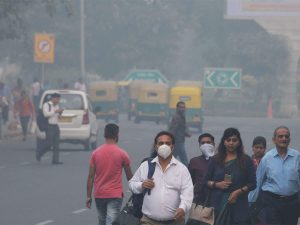Today Current Affairs: 24th March 2022 for UPSC IAS exams, State PSC exams, SSC CGL, State SSC, RRB, Railways, Banking Exam & IBPS, etc
Table of Contents
Minamata Convention On Mercury:

Indonesia has introduced a global declaration that calls on parties to the Minamata Convention on Mercury to tackle illegal trade of mercury.
- The declaration was read in Nusa Dua, Bali, where Indonesia is hosting the fourth Conference of Parties (COP4) to the Minamata Convention on Mercury.
- The conference is being held from 21st to 25th March 2022.
- The non-binding declaration calls upon parties to:
- Develop practical tools and notification and information-sharing systems for monitoring and managing trade in mercury.
- Exchange experiences and practices relating to combating illegal trade in mercury, including reducing the use of mercury in artisanal and small-scale gold mining.
- Share examples of national legislation and data and information related to such trade.
Minamata Convention on Mercury:
- The Minamata Convention on Mercury is a global treaty to protect human health and the environment from the adverse effects of mercury and its compounds.
- It was agreed at the fifth session of the Intergovernmental Negotiating Committee in Geneva, Switzerland 2013.
- Controlling the anthropogenic releases of mercury throughout its lifecycle is one of the key obligations under the Convention.
- The Convention also addresses interim storage of mercury and its disposal once it becomes waste, sites contaminated by mercury as well as health issues.
- The Convention covers all aspects of the life cycle of mercury, controlling and reducing mercury across a range of products, processes and industries. This includes controls on:
- mercury mining
- the manufacture and trade of mercury and products containing mercury
- disposal of mercury waste
- emissions of mercury from industrial facilities.
- Countries that have ratified the Convention are bound by international law to put these controls in place.
India has ratified the Convention.
Hypersonic Missiles Used By Russia For The First Time Amid Ongoing Ukraine Conflict:

Russia used a hypersonic missile for the first time in the ongoing conflict with Ukraine.
- A hypersonic missile is a weapon system which flies at least at the speed of Mach 5 i.e. five times the speed of sound and is manoeuvrable.
- The manoeuvrability of the hypersonic missile is what sets it apart from a ballistic missile as the latter follows a set course or a ballistic trajectory.
- Thus, unlike ballistic missiles, hypersonic missiles do not follow a ballistic trajectory and can be manoeuvred to the intended target.
- The two types of hypersonic weapons systems are Hypersonic Glide Vehicles (HGV) and Hypersonic Cruise Missiles.
- The HGV are launched from a rocket before gliding to the intended target while the hypersonic cruise missile is powered by air breathing high speed engines or ‘scramjets’ after acquiring their target.
- Hypersonic missiles can enable responsive, long range strike options against distant, defended or time critical threats (such as road mobile missiles) when other forces are unavailable, denied access or not preferred.
- Conventional hypersonic weapons use only kinetic energy i.e. energy derived from motion, to destroy unhardened targets or even underground facilities.
- India is also developing an indigenous, dual capable (conventional as well as nuclear) hypersonic cruise missile as part of its Hypersonic Technology Demonstrator Vehicle Programme and has successfully tested a Mach 6 scramjet in June 2019 and September 2020.
- India operates approximately 12 hypersonic wind tunnels and is capable of testing speeds upto Mach 13.
Wings India 2022 : Objectives

The Ministry of Civil Aviation, Airports Authority of India (AAI) and Federation of Indian Chambers of Commerce and Industry (FICCI) is jointly organising Wings India 2022 from 24th – 27th March 2022, Begumpet Airport, Hyderabad, India.
- It is Asia’s largest event on Civil Aviation (Commercial, General and Business Aviation).
Objective of Wings India 2022:
- It is in synergy with India’s commitment to transform the country into World’s top aviation hub.
- It seeks to provide a congenial forum catering to the rapidly changing dynamics of the sector, focusing on new business acquisition, investments, policy formation and regional connectivity.
- It will provide a much-desired fillip to the aviation and restructured focused forums shall be instrumental in attaining the objective of connecting the Buyers, Sellers, Investors, and other stakeholders at a common vantage forum ‘Wings India 2022’.
- India’s Civil Aviation is among the fastest-growing aviation markets globally and will be a major growth engine to make India a USD 5 trillion economy by 2024.
- 3rd largest aviation market by domestic air passenger traffic which stood at 274.05 million in FY20. It grew at a Compound Annual Growth Rate (CAGR) of 12.91% during FY16-FY20.
- 75 airports opened in 75 years of Civil Aviation in India while under the aegis of Ude Desh Ka Aam Naagrik (UDAN), within a span of 3 years, work has been initiated to provide scheduled connectivity to 76 unserved / 20 underserved airports, 31 heliports and 10 water aerodromes.
- 713 aircraft of scheduled Indian carriers operating year around; private scheduled airlines plan to add over 900 aircrafts in the next 5 years.
- Comprehensive regulatory policies and strategies adopted to reduce aviation carbon footprints.
- Incorporated systematic approaches to redress passenger grievances, and improve operational efficiencies across the system.
INS Shivaji : Centre of Excellence In The Field Of Marine Engineering

The Ministry of Skill Development and Entrepreneurship (MSDE) has recognised INS Shivaji as the Centre of Excellence (CoE) in the field of Marine Engineering.
- MSDE’s designation of INS Shivaji as a Centre of Excellence is the first of its kind for any military organisation, and it reflects the INS Shivaji’s continued commitment to skill and technology development.
- INS Shivaji is an Indian Naval Station in Lonavala, Maharashtra.
- It houses the Naval College of Engineering, which educates and trains Indian Navy and Coast Guard officials.
- It has three premier training entities, namely Centre of Marine Engineering and Technology (CMET), Centre of Excellence in Marine Engineering and School of Basic Sciences
- The Nuclear Biological Chemical Defence School, which trains naval personnel on all aspects of NBCD, is also located in the station.
- The naval Station was commissioned as HMIS (His Majesty’s Indian Ship) Shivaji in February, 1945.
- INS Shivaji’s Centre of Excellence (Marine Engineering) was established in 2014 with a broad mandate that included the induction of niche technologies for naval applications, quality research in collaboration with R&D (Research and Development) and academic institutes of high reputation.
- The larger goal here is to improve the skills of the personnel across the Indian Navy, Friendly Foreign Navies, and the entire ecosystem.
Centre of Excellence (CoE):
- CoE is a body that provides leadership, best practices, research, support, training of trainers and skill training for a specific sector/s.
- The literal meaning of a Centre of Excellence is – ‘A place where the highest standards are maintained’.
- As per the National Policy for Skill Development & Entrepreneurship, 2015, it was decided that National Skills Universities and Institutes will be promoted in partnership with States as centres of excellence for skill development and training of trainers.
- The Centre of Excellence in the skilling ecosystem is envisioned as a one-stop resource centre established/working in partnership with industry to raise training standards, boost productivity, address emerging skill gaps, and align training and research with industry needs.
- With the intent to overcome skill demand-supply mismatch, to have continuous supply of skilled workforce and disseminate best practices, “Centre of Excellence” is proposed to be recognized by the Ministry of Skill Development & Entrepreneurship (MSDE).
- The initiative will encourage such bodies already engaged in research and development activities in the skilling domain and allied fields to work on key emerging areas where there is knowledge deficit or skill gap, so as to set up Centres of Excellence.
Delhi Municipal Corporation (Amendment) Bill, 2022:

The Union Cabinet cleared a Bill that proposes to unify the three civic bodies in Delhi. The Delhi Municipal Corporation (Amendment) Bill, 2022, is expected to be tabled in Parliament this week.
- The amendment proposes a unified Municipal Corporation of Delhi by subsuming the South Delhi Municipal Corporation, the North Delhi Municipal Corporation and the East Delhi Municipal Corporation.
- The corporation was trifurcated in 2012.
- According to Government of India, The division of the corporation was uneven in terms of territorial divisions and revenue generation. As a result, there is a huge gap in the resources available to the three corporations, vis-à-vis their obligation.
- The gap has widened over time, increasing the financial difficulties of the civic bodies.
- At the moment the precise contours of the unified civic body are yet to emerge especially in terms of the composition of its legislature and the executive.
Haryana Prevention Of Unlawful Conversion Of Religion Bill, 2022:

The Haryana Assembly passed the Haryana Prevention of Unlawful Conversion of Religion Bill, 2022, even as Congress lawmakers opposed the Bill and staged a walkout from the House.
- The government says the Bill is aimed at preventing religious conversions “through force, undue influence or allurement” while former Chief Minister Bhupinder Singh Hooda said such a law would lead to an increase in the domestic disputes in the cases of inter-religion marriages.
- According to the Bill, the proof lies with the accused.
- If conversion is done by allurement, use of force, fraudulent means of coercion, then there is a provision of imprisonment of one to five years and a fine of not less than Rs 1 lakh.
- Similar Bills in the recent past have been passed in BJP-ruled states including Himachal Pradesh and Uttar Pradesh.
World Air Quality Report:

Bangladesh was the most polluted country in the world in 2021, says the World Air Quality Report prepared by the Swiss-based air quality technology company IQAir in its latest report released.
- In terms of particulate matter in the air, Bangladesh recorded an average PM2.5 level of 76.9 micrograms per cubic metre in 2021 against the World Health Organisation (WHO) recommended maximum permissible level of 5 micrograms per cubic metre.
- Earlier, in 2018, 2019 and 2020 also Bangladesh was found to be the most polluted country in the world.
- However, the PM2.5 level has shown a decline in Bangladesh from 77.1 micrograms per cubic metre in 2020 which was even higher at 83.3 in 2019 and 97.1 in 2018.
- The data reveals that not a single country in the world managed to meet the WHO’s air quality standard in 2021.
- All over the world, 93 cities reported PM 2.5 levels at 10 times the recommended level.
- Among the cities, Dhaka was the second most polluted city in the world with a PM 2.5 level of 78.1 just below New Delhi which had a PM 2.5 level of 85.1 in 2021.
- IQAir analysed data from 6475 cities across 117 countries for air quality in 2021 to arrive at the conclusion.
- Countries and regions in East Asia, Southeast Asia, and South Asia suffered from the highest annual average PM2.5 concentration weighted by population.
Protest Of Ahir Community:

Members of the Ahir community have been sitting on an indefinite protest near Kherki Daula toll plaza in Gurgaon since February 4, demanding the formation of an Ahir regiment in the Indian Army.
- The protests are being organised under the banner of ‘Sanyukt Ahir Regiment Morcha’, a group comprising Ahir community leaders from south Haryana.
- The protesters contend that the Indian Army had several caste-based regiments (for Sikhs, Gorkhas, Jaats, Garhwals, Rajputs).
- Since Ahirs had a large representation in the army, they want a separate regiment for Ahirs along similar lines.
- In the battle of Rezang La in 1962, out of 120 casualties, 114 were Ahirs.
- It is unfortunate that Ahirs have not got the recognition like other communities.
- The recruitment to President’s Bodyguard (PBG) is open only for Rajputs, Jats and Sikh regiments.
- Ahir or Aheer is a community in India, most members of which identify as being of the Indian Yadav community because they consider the two terms to be synonymous.
- The Ahirs are variously described as a caste, a clan, a community, a race and a tribe.
- The traditional occupations of Ahirs are cattle-herding and agriculture.
- They are found throughout India but are particularly concentrated in the northern area.
National Mission On Use Of Biomass In Coal Based Thermal Power Plants:

Commission for Air Quality Management recently reviewed the progress of Biomass Co-firing.
- Though some progress has been made towards co-firing, the CAQM finds the progress not up to the desired levels.
- In May 2021, to address the issue of air pollution due to farm stubble burning and to reduce carbon footprints of thermal power generation, Ministry of Power decided to set up a National Mission on use of Biomass in coal based thermal power plants.
Objectives of the mission:
- To increase the level of co-firing from present 5% to higher levels to have a larger share of carbon neutral power generation from the thermal power plants.
- To take up R&D activity in boiler design to handle the higher amount of silica, alkalis in the biomass pellets.
- To facilitate overcoming the constraints in supply chain of bio mass pellets and agro- residue and its transport upto to the power plants.
- To consider regulatory issues in biomass co-firing.
The Mission would have a Steering Committee headed by Secretary (Power) comprising of all stakeholders including representatives from Ministry of Petroleum & Natural Gas (MoPNG), Ministry of New & Renewable Energy (MNRE) etc.
- The Executive Committee would be headed by Member (Thermal), CEA. NTPC will play a larger role in providing logistic and infrastructure support in the proposed National Mission.
Biomass Cofiring:
- It refers to the concurrent blending and combustion of biomass materials with other fuels such as natural gas and coal within a boiler, which reduce the use of fossil fuels for energy generation and emissions without significantly increasing costs and infrastructure investments.
Direction On 100% Utilization Of Fly Ash:

Ministry of Environment, Forest and Climate Change (MoEFCC) has issued directives to form a committee for surveillance of pollution problems caused by Koradi and Khaparkheda coal-fired power plants in Nagpur. Both the plants have also been directed to ensure 100% utilization of fly-ash.
- Fly Ash Popularly known as Flue ash or pulverised fuel ash, it is a coal combustion product.
- Composed of the particulates that are driven out of coal-fired boilers together with the flue gases.
- Depending upon the source and composition of the coal being burned, the components of fly ash vary considerably, but all fly ash includes substantial amounts of silicon dioxide (SiO2), aluminium oxide (Al2O3) and calcium oxide (CaO), the main mineral compounds in coal-bearing rock strata.
- Minor constituents include: arsenic, beryllium, boron, cadmium, chromium, hexavalent chromium, cobalt, lead, manganese, mercury, molybdenum, selenium, strontium, thallium, and vanadium, along with very small concentrations of dioxins and PAH compounds. It also has unburnt carbon.
- All the heavy metals found in fly ash nickel, cadmium, arsenic, chromium, lead, etc—are toxic in nature.
- They are minute, poisonous particles accumulate in the respiratory tract, and cause gradual poisoning.
- For an equal amount of electricity generated, fly ash contains a hundred times more radiation than nuclear waste secured via dry cask or water storage.
- The breaching of ash dykes and consequent ash spills occur frequently in India, polluting a large number of water bodies.
- The destruction of mangroves, drastic reduction in crop yields, and the pollution of groundwater in the Rann of Kutch from the ash sludge of adjoining Coal power plants has been well documented.




